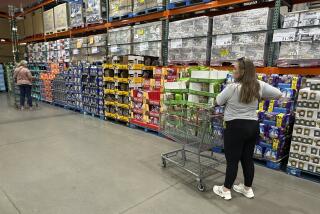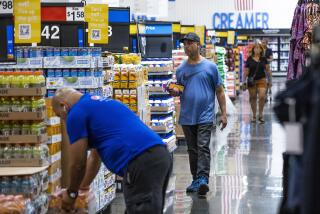Consumer Credit Slips Little in July After June’s Drop
- Share via
WASHINGTON — U.S. consumer borrowing was little changed in July after the biggest decline in more than nine years, a sign shoppers are turning cautious at a time the economy needs them to spend.
Consumer debt totaled $5 million less in July than it did a month earlier, the Federal Reserve said Monday. Credit card use and installment loans for autos and other large purchases were little changed. In June borrowing had fallen $1.8 billion, the biggest decrease since April 1992.
Combined, June and July marked the first time borrowing has failed to increase in consecutive months since a string of declines from March-June 1992.
Americans are purchasing fewer vehicles made by auto makers such as General Motors Corp. and spending less at Circuit City Group stores and other retailers because of mounting job losses and declines in the stock market.
“Consumer credit is under stress and there’s a good chance we’re in for tougher times,” said James Dimon, chief executive of Bank One Corp., the No. 6 U.S. bank.
The economy grew at a 0.2% annual pace in the second quarter, the weakest in eight years, and Fed officials have signaled that a rebound in growth may take longer than expected.
“The common view is the revival will be a little later and somewhat slower than people thought three or four months ago,” William Poole, president of the St. Louis Fed, said Monday.
After seven interest-rate cuts by the Fed this year, “there is considerable stimulus in the pipeline,” and that means the economy will start to rebound at some point, said Anthony Santomero, president of the Philadelphia Fed.
Still, recent economic data “is on the weaker side rather than the stronger side,” he said.
Comments from the two officials came during a question-and-answer session with reporters after speeches at the National Assn. for Business Economics annual meeting in New York.
Consumers may have had to borrow less in July because tax rebate checks of as much as $600 a household provided shoppers with cash to spend and allowed many to leave their credit cards in their wallets. The government began mailing $38 billion in rebates during the month.
Some consumers may have paid down debt because it’s taking up a larger portion of their income.
Consumers on average devoted 14.4% of disposable personal income to debt payments in the first quarter, up from 14.3% in the fourth quarter of 2000 and the highest in 14 years, the Fed’s household debt service burden survey showed in July.
Economists monitor the report as an indicator of consumer confidence, which typically leads to increased spending. The Conference Board’s index of consumer confidence unexpectedly dropped in August to a four-month low.
Installment loans, used for such purchases as boats, mobile homes, and schooling, totaled $888.94 billion in July, up slightly from $888.92 billion in June.
So-called revolving loans--debt incurred through the use of credit cards--totaled $700.25 billion in July, down marginally from $700.28 billion in June.
As the economy weakens, many lenders are feeling the brunt of unpaid credit cards and other personal loans.
Last week, the Federal Deposit Insurance Corp. said U.S. commercial banks earned $19.2 billion in the second quarter, down 4% from the previous quarter, as losses rose on business and credit card loans. Banks wrote off $7.9 billion of loans in second quarter, up 50% from a year earlier, the FDIC said. That included $2.8 billion in bad credit card debt.
More to Read
Inside the business of entertainment
The Wide Shot brings you news, analysis and insights on everything from streaming wars to production — and what it all means for the future.
You may occasionally receive promotional content from the Los Angeles Times.










